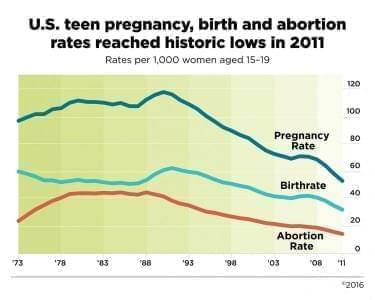Illinois Issues: Sixteen And (Not) Pregnant

Increased use of contraception is one reason for a drop in teen pregnancy rates. Wiki Commons
Teen pregnancy rates are going down in Illinois and across the nation because teens are having less sex, and when they do, they’re using contraception more often. The reasons behind these changes in behavior are harder to pinpoint.
Jean Doe, then 17, gave birth to a daughter in 1991 – the year that teen births reached their modern-day American peak.
Since then, the decline has been steady in the country – and in Illinois, where as a teenager in Springfield Doe had one daughter and then another. “I didn’t think it would happen to me,” says Doe, who explains her circumstance as naiveté and inconstant birth control use. (Editor’s note: Illinois Issues is not using Doe’s real name at her request to protect her family’s privacy.)
“Prior to having my my first daughter, there was no discussion with my parents or anybody about birth control.’’

Teen pregnancy rates continue to fall.
In Illinois, in 2014, the last year in which numbers are available, there were 9,691 teen births for a rate of 22.8 percent. That’s down a whopping 65 percent since the teen birth rate peaked nationally in 1991, and down 7 percent from the previous year. The teen pregnancy rate has dropped too, which experts say, indicates that the decline in pregnancies has not been the result of a rise of abortions. The opposite has happened. Abortion rates have declined, too.
“One the nation’s great success stories over the past two decades has been the historic declines in teen pregnancies and births,’’ says Bill Albert, chief program officer for the National Campaign to Prevent Teen and Unplanned Pregnancy. “It is down nationally by better than 50 percent. It is down in all 50 states, and it is down among all racial and ethnic groups.”
What accounts for this trend? “The short answer behind this magical situation is less sex and more contraception,” Albert says. “That is more teenagers are delaying sex and having fewer sexual partners, and those that are having sex are using contraception more consistently and carefully.”
That’s proven, experts agree. What is less clear is whether state and federal programs designed to combat teen pregnancy are behind those changes in teen behavior.
Studies, proponents point out, have shown that the comprehensive sex education programs, produced by places such as Harvard University, have signs of effectiveness, unlike abstinence-until-marriage campaigns.

State Sen. Heather Steans, a Chicago Democrat, was chief sponsor of a bill to require comprehensive sex education
Meanwhile, tens of millions have been spent nationally on programs since the Reagan administration aimed at touting abstinence, and Obama-era teen pregnancy prevention efforts revolving around comprehensive sex education that have boosted teen contraceptive use.
A funding fight in Congress appears to be giving an edge to the abstinence campaign even as the presidentially backed Teen Pregnancy Prevention Program’s provisions call for proven-effective plans.
In Illinois, sex education, if taught, is required to include information on medically accurate, safe sex and contraception, as well as abstinence, because of a recently-approved law that also struck long-time language that favored heterosexual marriage before sexual activity.
Sen. Heather Steans, a Chicago Democrat was a chief sponsor of House Bill 2675, which took effect in 2014. “I definitely think kids need access to quality sexual education information so they can make wise decisions for themselves,’’ she says.
Since then, the state has seen the program used in school districts in communities with some of the highest teen birth rates in the state, including Peoria and Decatur.
Among opponents to the bill, was Republican Sen. Kyle McCarter of Lebanon, who says, “abstinence always works.’’

Sen. Kyle McCarter opposed a bill calling for comprehensive sex education.
“I think you send the wrong message to young people when you tell them that you’re going to outfit them with all the ways possible to keep from getting pregnant because you’re making the assumption they’re going to have sex as a teenager,” McCarter says.
Illinois is one of 24 states (and the District of Columbia) that require sex education, says Elizabeth Nash, senior state issues manager for the Guttmacher Institute. With the adoption of the comprehensive sex ed bill, information about contraception has to be provided in general health education, she says.
Prior to the new law, Illinois schools teaching sex education had to encourage abstinence before marriage, she notes. The end to that is important because “what we know (is that) people are getting married later in life so there’s a fairly wide gap between first having sex and being married or being in a committed relationship. So we want to make sure people have the information they need to be good partners, to make responsible decisions, to understand contraception and to use contraception. Along with all of the other things we want them to know about before entering into a sexual relationship and being a happy and healthy person.”
Illinois had turned down abstinence dollars offered by the federal government since at least 2010, but Gov. Bruce Rauner’s administration applied for and received a $2.7 million grant for the Illinois State Board of Education for Fiscal Year 2016. A spokeswoman for Rauner says it makes sense to get every available federal dollar.
Still, Nash calls Illinois, “a bright spot” with its recent “focus on medically accurate comprehensive sex education.” As an example, she points to a $4-million-a-year program that was in place in the Chicago Public Schools system between 2010 and 2015.
Can the drop in teen pregnancy be attributed to more teens getting information on safe sex and contraception at school? Not necessarily. “You see the drop in every single state no matter what the policies are in that state,” says Heather Boonstra, who is director of public policy at the Guttmacher Institute, which follows reproduction-related issues. She and her peers suspect there is more at play than policy choices.
The use of birth control does appear to be a big part of the decline in teen births. Linda Diamond Shapiro, the interim chief operating officer of Planned Parenthood of Illinois, says, “The major reason I would point out first and foremost to the fact that birth control is more accessible to youth. ’’
She notes that birth control is covered through the Patient Protection and Affordable Care Act, otherwise known as Obamacare.
“In particular, we now offer long-acting reversible contraception (LARC). What it really means are IUDs and implants, which are long-term solutions and maintenance-free so once a teen uses a LARC method, they really are protected without having to make any other on the spot decisions.” Shapiro says these methods are seen as the most effective forms of contraception.
“They have changed and are quite safe. But not only are they safe, for teens they are the first-line recommended form of birth control recommended by the American College of Obstetrics and Gynecology and the American Academy of Pediatrics.”
But the increased availability of safe, reliable and reversible contraception can’t take all of the credit, either. Experts in the area point to several other reasons, including media and social media portrayals of the negatives of early parenthood, more frankness among in families about discussions of sex and a generational inclination to avoid risky behaviors.
Media portrayals of the downside of teen pregnancy — only 40 percent of those who give birth as teens finish high school, and they are more likely to live in poverty — and the rise of social media, which supports communication between teens are also playing a part.
Albert of the National Campaign says, “I think the the MTV shows 16 and Pregnant and Teen Mom that have been watched by tens of millions of young people over the years has had a very sobering effect on teens that watch it. Teens have said in survey after survey that they find these shows more sobering than salacious, that they almost find them as sex education for the 21st century.
“I think (for) anyone who has seen these shows, it’s quite clear how challenged many of these young women are getting pregnant and having children at a young age. So it certainly makes sense. Even if you don’t believe the teenagers themselves, there has been serious red meat research on the effectiveness of these show.”
A 2014 study from University of Maryland, the Brookings Institution and Wellesley College found that in the 18 months following the 2009 premiere of 16 and Pregnant, a 5.7 percent reduction in teen births occurred, which accounts for around one-third of the overall decline in teen births over that time.
Jean Doe from Springfield remembers the consequences of early parenthood well. “While all my friends went away to college, I was worrying about taking care of a baby and having a job and providing for her rather than doing what most 18 to 20 year olds – kids my age – were doing.”

Part of the decline in teen pregnancies is because of youth sharing information through social media, experts say.
And the teens themselves are a source of information, Shapiro says. “Teens are very much connected to each other through social media. They are getting information from each other that they respect, and there is quite a bit of good information out there electronically perhaps in a way that you know wasn’t it years past. Teens, I think, are savvy and they know how to look for information.”
Based on their activities, they may be good influences on one another. According to most recent results from the Centers for Disease Control and Prevention’s National Youth Risk Behavior Survey, fewer teens are having sex, drinking and smoking than they were when the survey began in 1991.
“It would be fair to say reading that report that teenagers today might safely be called the cautious generation,’’ says Albert of the National Campaign. “I think we as adults in our minds’ eye when we think of teens it is almost a blur of bare midriffs and that things are bad and getting worse. In fact, the opposite is true.”
He is not alone in that assessment.
“I think the millennials are in general they’re less accepting – teenage girls in particular, are less accepting of being pressured into having sex,’’ says Robert Gilligan, executive director of the Catholic Conference of Illinois.
Gilligan says he thinks teens understand the risks associated with sex and that they are interested in building relationships. “I think by delaying sex, there’s a better life for them ahead, and I think that message is getting through to them, and I think that’s a big reason why we’re seeing a decline in teen birth rates, especially in the last couple of years.”
Better communication between parents and children is another factor.
Doe recalIs: “I think when I was a teenager my parents never talked to me about things like birth control or being sexually responsible, things like that. And I felt that I couldn’t come to them. As opposed to with my girls and their friends … it was an open topic and an ongoing discussion. It wasn’t one sit-down talk and that was the end of it. I think I create an environment and their friends’ parents create an environment (where it comfortable to talk about sex). “It wasn’t taboo or let’s not talk about it.”
Albert says that parents have a big role to play. “Surveys say the most impact (on teens) is what parents say,” he says — even greater than peers or relationship partners.
The educational programs backed by the Obama administration are all about “talking about it.” Decatur Planned Parenthood clinic is using one called Safer Sex Intervention, which was developed and tested at Harvard.
Decatur was chosen to participate because Macon County teen birth rates — at 53 births per 1,000 — are about twice the state average and were recently the highest in Illinois. The program is designed to increase condom use and to prevent sexually transmitted infections (STI). Participants between the ages of 13 and 23 are offered the program when they come into the clinic.

Krystie Callarman is health educator for a teen pregnancy prevention program in Decatur.
Those who accept get a 20 to 40 minute visit with the clinic’s health educator for individual, intensive instruction. “We want to meet the youth where they’re at. We want them to feel comfortable,” says Julie Aubert, Youth Services Manager for PPIL.
“If they accept the program and go through that, we will accept them and follow them individually up to six months,” she says. The clinic reaches out using text messaging, email or however participants are comfortable being contacted.
This program is funded at least through next year, but the future of similar programs may be in jeopardy. “The biggest indication of that … is the rise again of the abstinence-only and pro-marriage program. And the reason I say that is Obama suggested eliminating the (abstinence) programs, Congress came back and approved them, and so after years of large spending in this area, we saw a decrease, and now its crawling back up again,” Boonstra says.
This year, the U.S. Senate voted to reauthorize level funding at $101 million for the national Teen Pregnancy Prevention Program that President Barack Obama successfully pushed in his first budget in 2008, but a congressional subcommittee this summer voted to defund it.
Meanwhile, Congress reauthorized other abstinence-related programs for Fiscal Year 2017, including a $75 million appropriation million for the President George W. Bush-era Personal Responsibility Education Program.
Congress is not expected to take action before it returns in December from a two-month break.
Albert says such programs are needed because the advocates to end teen pregnancy still have work to do, including the need closely a racial disparity: African American and Hispanic teens are far more likely to be pregnant than their white counterparts.
“The glass half full interpretation is there has been historic declines. He says “the half-empty interpretation” is that rates in the nation are far higher than for those in western Europe and Japan.
“While we celebrate the historic declines the nation has made, it is not time to hang a mission accomplished banner.” Rates that have gone down, could go back up again. “We have to continue to underscore that we need to come up with new solutions for each generation of children.
“As far as I know, they haven’t created a vaccine for teen pregnancy.”
Illinois Issues is in-depth reporting and analysis that takes you beyond the headlines to provide a deeper understanding of our state. Illinois Issues is produced by NPR Illinois in Springfield.
Links
- Pregnant Workers To Be Protected Under New State Law
- Pregnancy Hormone May Reduce Multiple Sclerosis Symptoms
- When Being Pregnant Also Means Being Out Of A Job
- Illinois Issues: Mike Madigan And The ‘Party Of Economic Opportunity’
- Illinois Issues: What’s Up With The Judicial ‘Smackdown’ Of Remap Referendums?
- Illinois Issues: Rewriting The Rule Book
- Illinois Issues: Historic Dilemma

